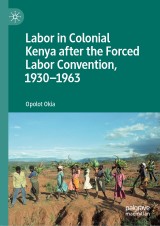Details

Labor in Colonial Kenya after the Forced Labor Convention, 1930-1963
|
90,94 € |
|
| Verlag: | Palgrave Macmillan |
| Format: | |
| Veröffentl.: | 23.08.2019 |
| ISBN/EAN: | 9783030176082 |
| Sprache: | englisch |
Dieses eBook enthält ein Wasserzeichen.
Beschreibungen
This book advances research into the government-forced labor used widely in colonial Kenya from 1930 to 1963 after the passage of the International Labor Organization’s Forced Labour Convention. While the 1930 Convention intended to mark the suppression of forced labor practices, various exemptions meant that many coercive labor practices continued in colonial territories. Focusing on East Africa and the Kenya Colony, this book shows how the colonial administration was able to exploit the exemption clause for communal labor, thus ensuring the mobilization of African labor for infrastructure development. As an exemption, communal labor was not defined as forced labor but instead justified as a continuation of traditional African and community labor practices. Despite this ideological justification, the book shows that communal labor was indeed an intensification of coercive labor practices and one that penalized Africans for non-compliance with fines or imprisonment. The use of forced labor before and after the passage of the Convention is examined, with a focus on its use during World War II as well as in efforts to combat soil erosion in the rural African reserve areas in Kenya. The exploitation of female labor, the Mau Mau war of the 1950s, civilian protests, and the regeneration of communal labor as harambee after independence are also discussed.<p></p>
1 Introduction: Communal Forced Labor as a Mask of Tradition.- 2 ''Skinny Scarecrows'': Forced Labor in Kenya before the Forced Labor Convention.- 3 The Tactical Compromise: The 1930 Forced Labor Convention and Kenya Colony.- 4 Interlude: Forced Labor during WWII.- 5 Protecting the Soil (1): Communal Labor and Land Degradation in Central Province.- 6 Protecting the Soil (2): Communal Labor and Land Degredation in Nyanza Province.- 7 Controlling ''Spivs'': The ILO and Emergency Communal Labor, 1952-1960.- 8 Conclusion: The Phoenix of Abolition.-
<p><b>Opolot Okia</b> is Professor of African History at Wright State University, USA. He is the author of <i>Communal Labor in Colonial Kenya: The Legitimization of Coercion, 1912-1930</i> (Palgrave Macmillan, 2012) and was previously a Fulbright Scholar at Makerere University in Uganda and Moi University in Kenya. </p>
This book advances research into the government-forced labor used widely in colonial Kenya from 1930 to 1963 after the passage of the International Labor Organization’s Forced Labour Convention. While the 1930 Convention intended to mark the suppression of forced labor practices, various exemptions meant that many coercive labor practices continued in colonial territories. Focusing on East Africa and the Kenya Colony, this book shows how the colonial administration was able to exploit the exemption clause for communal labor, thus ensuring the mobilization of African labor for infrastructure development. As an exemption, communal labor was not defined as forced labor but instead justified as a continuation of traditional African and community labor practices. Despite this ideological justification, the book shows that communal labor was indeed an intensification of coercive labor practices and one that penalized Africans for non-compliance with fines or imprisonment. The use of forced labor before and after the passage of the Convention is examined, with a focus on its use during World War II as well as in efforts to combat soil erosion in the rural African reserve areas in Kenya. The exploitation of female labor, the Mau Mau war of the 1950s, civilian protests, and the regeneration of communal labor as harambee after independence are also discussed.
Covering the period following the author’s previous volume, Communal Labor in Colonial Kenya: The Legitimization of Coercion, 1912-1930, this study explores the role of forced labor in rural Kenya throughout the 1930s, 1940s and 1950s Shows how coercive labor practices continued in colonial East Africa following the passage of the ILO’s Forced Labor Convention in 1930 Explores how communal labor was manipulated by the British administration as a form of punishment for those civilians thought to be supporting the Mau Mau rebellion in the 1950s
Diese Produkte könnten Sie auch interessieren:

Deportationen aus der Westukraine von 1947-1952 und die ukrainische Nationalbewegung

von: Julia Ramchen

18,99 €
















